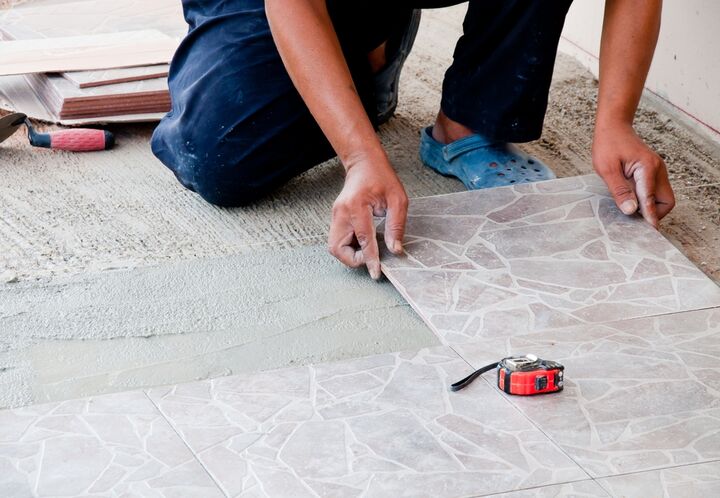
Styling your home through tire flooring
Tile flooring can be stylish, attractive, tough and easy to clean. There are many styles of tiles to choose from depending on your preferences and requirements. Examples of tile flooring that you can use are stone flooring, terrazzo tiles, terra cotta, ceramic tile, porcelain tiles, vinyl tiles and linoleum.
Tile Flooring, a historical perspective
Tile flooring has been the favorite of many homeowners for centuries, and why not? There are many good reasons why people still prefer tile flooring over any other kinds of flooring. Allow us to give you a short history of tile flooring so that you may be able to fully appreciate it. So the next time you visit your shop with your wife, you will say “Hey, honey. Why don’t we use tiles for our flooring. I mean, they have been used by kings and queens, and it’s perfect for kings and queens like us!” and your wife will say “Hell yeah!”
Seriously, tile flooring is the same age as that of pottery, which originated in China sometime 20,000 BC. Yes, tile flooring is about the same age because tile and pottery are closely associated with each other due to the material requirements. Most of the tiles then are made up of porcelain but to make them more stylish, ancient Chinese painted images on the tiles.
Ancient Egyptians likewise incorporated stone and ceramic tiles into their infrastructures. The earlier Egyptian tiles were made out of ceramic clay that was dried under the sun. However, since technology is constantly evolving, Egyptians made use of kiln drying and was believed that the Egyptians were the very first one to use kiln drying method. These practices in tile making, together with the Chinese practices, were made popular by nomadic Persian traders.
The Greeks, om the other hand, used stones to create tiles. They made new heights in tile making by not just creating patterns and designs on their floor but also the Greek god images. Greeks made use of stone materials such as marble and travertine, and ceramic as well. Since tiles are durable, they can still be uncovered during archaeological digs.
Different countries will have their respective designs for their tile flooring to represent their own culture. Nowadays, designs of tile flooring varies on the preferred interior design of the homeowners.
Tile flooring that suits you
As mentioned above, there are different materials to make tile flooring. It all depends on you on which type of tile to choose. Here are the different tiles that are commonly used and are available in the market:
1. Stone flooring – this tile flooring can create mood of formality or even relaxed informality which greatly depends on the type of stone used. For instance, if you use marble stone, then you are setting formality, while flagstone floors sets informality. Likewise, the natural color and pattern of the stone floor tiles are classical in appearance.
2. Ceramic tiles – made form clay and kiln dried. Colored glazed are then added to make them attractive. This tile can be slippery such as abrasive are treated.
3. Porcelain tiles – clay tiles and fired at very high temperatures and can be resistant to moisture.
4. Terrazzo tiles – formed from marble or other stone chips and are embedded in concrete. The surface is then polished to make it more attractive and for easy cleaning.
5. Terra cotta – clay tile that has been fired but not colored. Think of the materials used in garden pots.
6. Vinyl tiles – this type of tile has been developed after World War 2. Good thing about vinyl tile is that they are inexpensive and easy to install.
7. Linoleum tile – made up of natural materials with low energy processes. It does not contain any toxins and are mildly antibacterial. They come in wide range of colors that would likewise set up the mood of your home.
For you to have a good quality tile flooring, you should consider some factors such as the location the tile flooring will be used. Will it be installed indoor or outdoor? What room will they be installed and is it a wet area? You should also consider the foot traffic the room is going to experience daily. Once these have been answered, then the right tile flooring will be installed in your designated areas. For example, if you are installing tile flooring indoor in an area where there is heavy foot traffic such as the hallway, then you will be needing tiles that has high abrasion resistance to minimize wear and tear. Bathrooms need tiles with low water absorption and textured to prevent moisture damage and bathroom accidents.
 Australia
Australia
 Austria
Austria
 Belgium (Dutch)
Belgium (Dutch)
 Canada (English)
Canada (English)
 Denmark
Denmark
 Estonia
Estonia
 Finland
Finland
 France
France
 Germany
Germany
 Ireland
Ireland
 Italy
Italy
 Luxembourg (French)
Luxembourg (French)
 Netherlands
Netherlands
 New Zealand
New Zealand
 Norway
Norway
 Poland
Poland
 Portugal
Portugal
 Romania
Romania
 Singapore
Singapore
 Spain
Spain
 Sweden
Sweden
 Switzerland (French)
Switzerland (French)
 USA
USA
 United Kingdom
United Kingdom
 Other Countries
Other Countries




